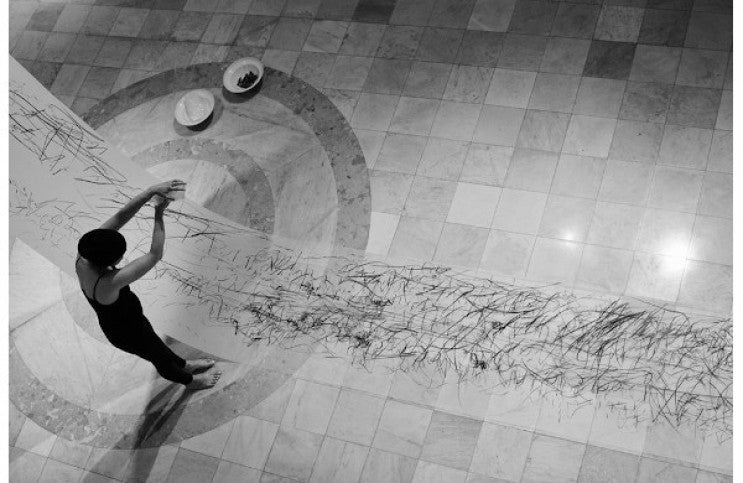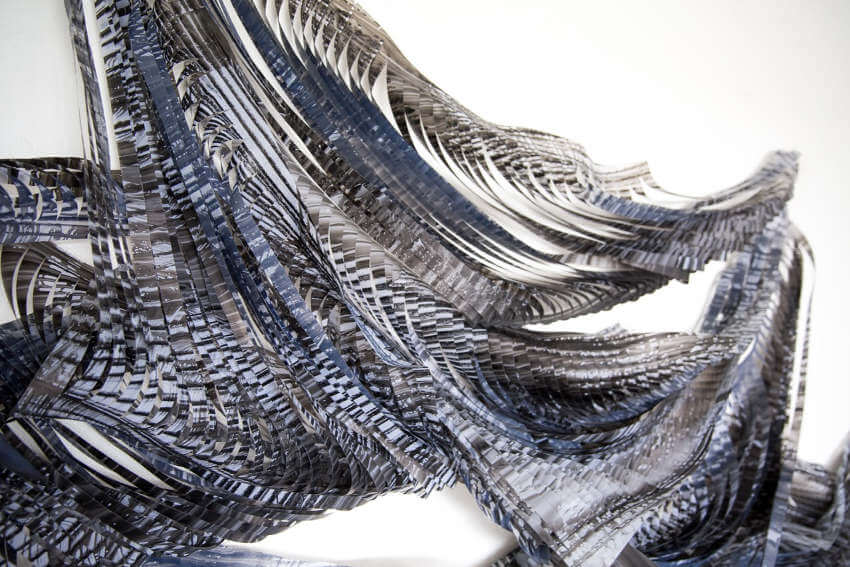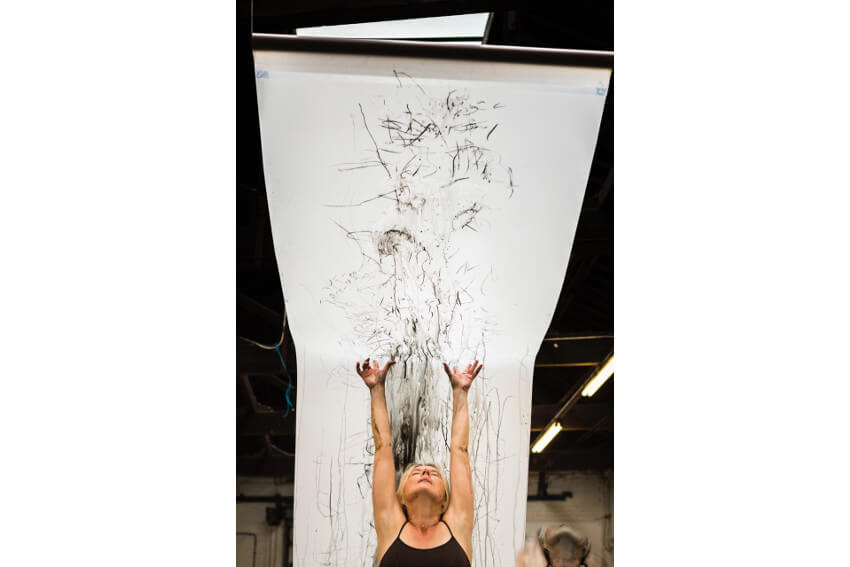
Jaanika Peerna Interview: These Waters Have Stories to Tell
Jaanika Peerna embodies nature. In her performances, she flows with the rhythms of air and water. To the eye, her movements appear both intuitive and inevitable. She is creating something new on the spot, but viscerally, we feel we are watching something ancient unfold. The drawings that emerge from her actions are artworks in themselves, but they are also relics of an event—an echo of the meeting of movement, elements and time, like lines on a beach after a wave retreats, or wind-worn ridges in a seaside cliff. In addition to performance, the oeuvre of the Estonian-born, New York-based Peerna includes drawing, video, and installation. She is one of six artists participating in These Waters Have Stories To Tell, an exhibition opening on 19 January in Swansea, Wales, presented by Ephemeral Coast, a curatorial project that “seeks to develop a nexus of understanding between art, empathy, and the degradation of the ocean.” Peerna will perform as part of the exhibition, and will also exhibit a large-scale, 3-D wall installation and another sculptural wall piece. A video of the performance will remain on view throughout the exhibition. We recently spoke with her about the exhibition, about her process, about her connection to nature, and about the relationship between art, spectators and the environment.
IdeelArt: How are your drawings, as relics of a process, unique from your performances?
Jaanika Peerna: Such a good question. This pinpoints the very question that is in the center for myself as well. Solitary studio practice has always been very separate from the public performances I do. But as time has passed and my practice has deepened I notice they share a lot. In both cases I am much more interested in the process than any kind of material outcome. It is as if traces of an activity have been left behind and the traces have value as long as they mark down or contain some essential aspects of the activity. The outcome that matters is a transformative impact. With studio work, the resulting drawing or sculptural work will have to stand on it’s own as a container of the act taken place. But with performance, the movement and energy exchanged in the common space with the audience is all that matters.
IA: Do you believe that a viewer who encounters your performance has access to levels of meaning that are not perceptible to a viewer who only sees the drawing afterward?
Peerna: Yes, absolutely. Lately my performances have become more directly participatory by the audience when I literally invite people to hold my paper or slide melting ice blocks along drawings. Drawings or sculptural forms might carry some of the energy moved around during the performance, yet the most important is hopefully carried around within each body (participant, audience member) who was part of the performance.
IA: How does the coastline relate to your feelings about your work?
Peerna: Shoreline is in constant flux. There is no one line that is the coastLINE. It is an ever changing entity. And it follows very precise rules determined by numerous conditions and forces. There are related qualities in the way I am working, and in the work that ends up from this approach: I am setting up certain rules and limitations before starting a new work (in terms of materials, surface, act or method) and none of my works end up being FIXED entities. They are either literally moving as the air moves around them, or they have dynamic visual elements so they never seem the same as you keep looking back at them. Just like the shoreline. While I can never compete with nature, there is much I can learn from the workings of it in order to embody its force, which ends up making my works through me.
 Jaanika Peerna - Glacier Elegy performance, Glynn Vivian
Jaanika Peerna - Glacier Elegy performance, Glynn Vivian
IA: What do you hope your performance adds to the experience viewers have at These Waters Have Stories To Tell?
Peerna: I hope it is something I can’t even quite foresee. What I know is the performance will give the participants a chance to be part of the process, to be physically immersed in it in real time, and some of them will get WET. The performance is called Glacier Elegy (Swansea), and in terms of materials, it uses a very long piece of plastic paper in mid-air, water soluble pigment pencils, and blocks of ice. I set my rules and limitations, but what exactly happens is dependent on the participants and the energy exchanged between me and them, the site, and time. Not unlike solving our current environmental crises, nature has its rules and needs, and we have our choices how to act.
IA: This is fascinating. The work allows itself, in part, to be determined by the choices the public makes as a group. It is similar to a political action. Does your work contain a “call to action,” or do you see it as socially and politically neutral?
Peerna: I am not an activist. That is not what I do best. But I do hope to get under the skin of some people who encounter my work. I hope to inspirethe audience to connect in a deeper way with nature and it’s workings, so care and action can result from it. Perhaps.
IA:You say perhaps. So you remain open. That keeps with the poetic elements of your work. Do you feel such poetics fit with the discussion contemporary humans are having about the future of our natural environment?
Peerna: I think they do, very much so. Poetry has power that is hard to measure, yet we know it can have strong impact. Why, otherwise, would we turn to poetry when joy is overwhelming, or in times of hardship? Poetic approaches are not linear or didactic. Their workings are hard to describe. But we know the transformation they can bring on.
 Jaanika Peerna - Sublime Ooze (detail)
Jaanika Peerna - Sublime Ooze (detail)
IA: What is the relationship between your art materials and the environment?
Peerna: This is something I give thought to quite often since I am using essentially plastic as my main material. This thin, frosty, half-translucent material has caught me working with it already for 10 years. Initially it felt very much like the ice I used to skate on as a child. And now I feel like I have gotten to know the material so well, created this whole relationship with it, that it is hard to let it go.
IA: That sentiment is so relatable. None of us wants to let go of the things we rely on, even when they might be harmful. It is a contradiction of humanity, and nature. The waves diminish the shore, but also build it up. Is this complex relationship between humans and nature partly what attracted you to work with Ephemeral Coast?
Peerna: Ephemeral Coast, which was founded by Celina Jeffrey, has environmental degradation at the heart of the projects it initiates. It takes coastline as the specific geographical area where it focuses its attention. My obsession with shoreline has been lifelong, from growing up on the shores of the Baltic Sea in Soviet-era Estonia, where shoreline was identical with the much protected border of the Soviet Union, to living on the shores of the Hudson river in the U.S.A. for the past 19 years, to working on art projects in Barcelona, Venice, Sydney, and other locations close to the water. Water is solace. Water is life. Water takes endless forms that keep me awake as an artist. It can flood everything, but it can also nourish you back to life. I take my deepest breaths on coast. I hide my tears in the winds of the Atlantic. Coasts have definitely been open air sanctuaries for me, and they connect the dots of glimmering moments of truth that I encounter.
 Jaanika Peerna in front of her work, photo by Marco Berardi
Jaanika Peerna in front of her work, photo by Marco Berardi
You can visit Jaanika Peerna on the web, or check out her work on IdeelArt. These Waters Have Stories To Tell runs from 19 January through 13 March 2018 in the Glynn Vivian Art Gallery, Swansea, Wales, United Kingdom, and features work by Jaanika Peerna, Julia Davis, Alexander Duncan, Shiraz Bayjoo, Sylvia Safdie, and Christian Sardet and The Macronauts. For more information, visit ephemeralcoast.com.
Featured image: Jaanika Peerna with melting ice block, Glacier Elegy, performance at These Waters Have Stories to Tell.
All images used for illustrative purposes only






